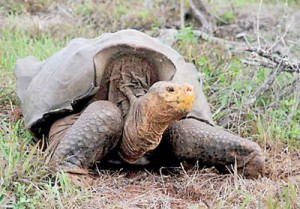Sunday Times 2
Giant tortoises rally from near extinction on Galapagos island
View(s):WASHINGTON (Reuters) – Conservationists said they have brought giant tortoises found on the Galapagos island of Espanola back from the brink of extinction, gaining a foothold strong enough to allow humans to leave the reptiles alone.
Numbering just 15 some five decades ago, the tortoises, which can live as long as two centuries, now number about 1,000 and can sustain themselves, according to a study published in the scientific journal PLOS ONE.

A giant tortoise is shown on the Galapagos island of Espanola (REUTERS/JAMES P. GIBBS, SUNY-ESF/ HANDOUT)
“We saved a species from the brink of extinction and now can step back out of the process. The tortoises can care for themselves,” said James Gibbs, a vertebrate conservation biology professor at the State University of New York (SUNY) College of Environmental Science and Forestry who led the study.Located in the Pacific about 600 miles (1,000 km) west of Ecuador, the Galapagos archipelago is home to an array of unusual creatures that helped inspire Charles Darwin’s theory of evolution by natural selection following his 1835 visit.
Española giant Galapagos tortoises, their scientific name is Chelonoidis hoodensis, measure 3 feet (1 meter) long with a saddle-backed shell.
They live up to 150 or 200 years, eating grasses and leaves during the wet season and cactus during the dry season on an arid, low, rocky island measuring only 23 square miles (60 square km). “The tortoises were hunted by buccaneers, whalers and other sea goers throughout the 18th and 19th centuries,” added Linda Cayot, a herpetologist who is science advisor to the Galapagos Conservancy group.
“They collected them live, stacked them in their holds, and had fresh meat on their long voyages. Tortoises can live up to a year without food or water, so a natural source of fresh meat,” she said

